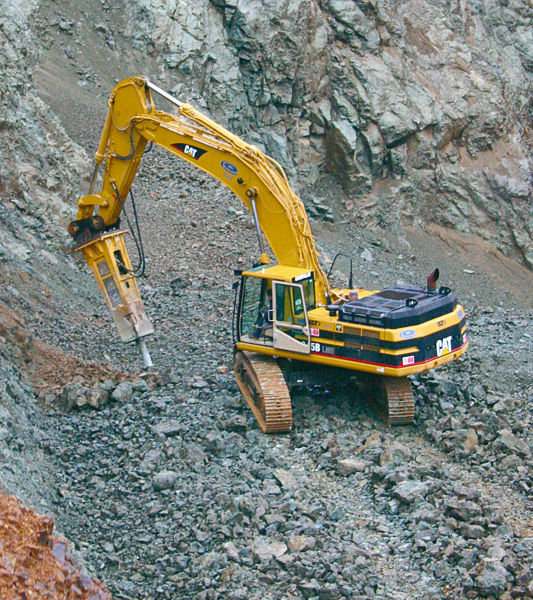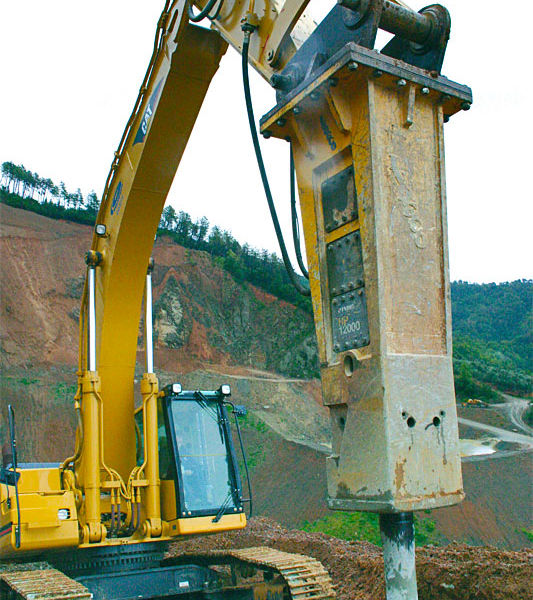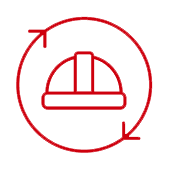More than just demolitions for the HP 12000
There are now plenty of areas where hydraulic breakers can show off their many great qualities. One of those is in quarry working, where hydraulic breakers have replaced the use of explosives, a technique which used to cause so many problems. And so off we went to visit a quarry where we found an Indeco HP 12000 hard at work.
The quarry
The jobsite we were visiting for the test is called Acquafredda, near the northern Italian city of Genoa. For many years, the quarry has been a source of top-quality highly abrasive basalt rock, which tends to cause plenty of wear and tear to the machinery used for extracting it. According to a recent survey by Italcementi, the productivity of the quarry is around 250,000 m3 a year of finished product, which is then reduced to the size required (sand, gravel, etc.) by a primary and secondary crusher plant located on site.
The contract for extracting the material and taking it to the crusher plant was awarded to the Benzi Remo firm from Piedmont, and until a few weeks ago they used the traditional technique of drill and blast. This proved to be so costly and complex, and the sheer size of the blocks lowered productivity, raised wear and tear and increased breakages on the crushers, that in conjunction with the quarry owners, the company decided to try out a hydraulic breaker mounted on an excavator. They contacted the Recmac firm, based in Buriasco, exclusive Indeco dealers for north-western Italy, who agreed to let them test an HP 12000 hydraulic breaker (mounted for this trial on a Cat 345B LME excavator). Back at the quarry, a test campaign began to see how the equipment would respond in the field, both in terms of productivity and reliability.
The breaker at work
To get a better idea of how the HP 12000 fared, we went to the quarry to meet Remo Benzi, the extraction subcontractor. “We decided to go for the test”, he told us, “for a whole series of reasons, principally based on cost – two areas which are particularly expensive are the purchase and detonation of the explosives themselves, and the costs associated with using a rock drill to prepare the holes needed for blasting.
From a purely operational point of view, the downtimes associated with this extraction technique were always lengthy, but the main disadvantage was the size of the material it produced, which was far too big and needed to be reduced before it could be taken to the crushing plant. Last but not least, using explosives has a detrimental impact on the environment, and also affects the operators and the local population.
This all led the company to try out the hydraulic breaker-excavator combination: “Once we’d made up our minds, we carried out some research into the type of material present in the quarry and the productivity needed to keep the crusher plant going, and the best choice seemed to be the IndecoHP 12000“.
The test cycle was a resounding success. “The impact on the production cycle was really quite considerable”, said Benzi. We no longer had to maintain a “difficult” piece of equipment like a rock drill, which we only used on a pretty occasional basis; with the excavator, it’s quite different – even when you’re not using a hydraulic breaker, the excavator can be used for plenty of other jobs. And that means getting rid of all the problems connected with using explosives, which I mentioned before. The most outstanding benefits, though, came with the productivity improvements.
The way the HP 12000 automatically regulates the frequency and energy of its blows enabled us to carry on extracting roughly a thousand cubic metres of material a day; but far more importantly, the material it extracts is already the right size for crushing. This means that the crushers get less wear and tear, so we have less breakdowns and broken parts, but most of all their productivity goes right up, sometimes by 50% or more”.
And finally, some great news on the operating costs. “Even though this wasn’t really a huge priority for us”, concluded Benzi, “you can mark my words, this was a very pleasant surprise. In financial terms, the tests showed that blasting with explosives costs so much more than using the breaker, and even when you take into account that the tools need replacing quite regularly, because the material is just so abrasive, and the costs of lubricating the equipment and the down-times every six months for maintenance, the savings are still more than satisfactory.”









